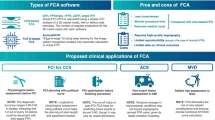Summary
The purpose of this study was to determine whether coronary collateral blood flow changes in response to repeated brief periods of ischemia in dogs in which no attempt has been made to stimulate collateral vessel development. The dogs were instrumented with aortic and left atrial catheters and a balloon occluder on the left circumflex coronary artery and were studied in the awake state the following day. Blood flow to the collateral dependent myocardium was measured using 9 μ radioactive microspheres during four coronary occlusions of two minutes duration, each separated by one hour of reperfusion. A small but statistically significant increase in mean collateral blood flow was noted between the first and fourth occlusions; .03 to .05 ml/min/g. These data suggest that transient periods of brief ischemia may result in increases in collateral blood flow.
Similar content being viewed by others
References
Brazzamano S, Mays AE, Rembert JC, Greenfield JC, Jr Increase in collateral blood flow following repeated coronary artery occlusion and nitroglycerine administration. Circ Res (In Press)
Geft IL, Fishbein MC, Ninomiya K, Hashida J, Chauz E, Yano J, Y-Rit J, Genov T, Shell W, Ganz W (1982) Intermittent brief periods of ischemia have a cumulative effect and may cause myocardial necrosis. Circulation 66:1150–1153
Jennings RB, Sommers HM, Smyth GA, Flack HA, Linn H (1960) Myocardial necrosis induced by temporary occlusion of a coronary artery in the dog. Arch Pathol 70:68–78
Jugdutt B, Becker LC, Hutchins GM (1979) Early changes in collateral blood flow during myocardial infarction in conscious dogs. Am J Physiol 237:H371-H380
Khouri EM, Gregg DE, McGranahan J (1971) Regression and reappearance of coronary collaterals. Am J Physiol 220:655–661
Marcus ML, Kerber RE, Ehrhardt J, Abboud FM (1976) Effects of time on volume and distribution of coronary collateral flow. Am J Physiol 230:279–285
Rivas F, Cobb FR, Bache RJ, Greenfield JC Jr (1976) Relationship between blood flow to ischemic regions and extent of myocardial infarction. Circ Res 38:439–447
Schaper W, Pasyk S (1976) Influence of collateral flow on the ischemic tolerance of the heart following acute and subacute coronary occlusion. Circulation 53:Suppl I. 157–162
Swain JL, Parker JP, McHale PA, Greenfield JC Jr (1979) Effects of nitroglycerine and propranolol on the distribution of transmural myocardial blood flow during ischemia in the absence of hemodynamic changes in the unanesthetized dogs. J Clin Invest 63:947–953
Whalen DA Jr, Hamilton DG, Ganote CE, Jennings RB (1974) Effect of transient period of ischemia on myocardial cells. Am J Path 74:381–397
Author information
Authors and Affiliations
Additional information
This study was supported in part by the National Institutes of Health Grant HL 18468 and the Medical Research Service of the Veterans Administration.
Rights and permissions
About this article
Cite this article
Brazzamano, S., Fedor, J.M., Rembert, J.C. et al. Increase in myocardial collateral blood flow during repeated brief episodes of ischemia in the awake dog. Basic Res Cardiol 79, 448–453 (1984). https://doi.org/10.1007/BF01908145
Received:
Issue Date:
DOI: https://doi.org/10.1007/BF01908145




